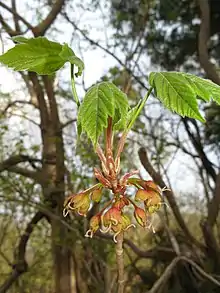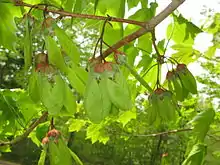Acer diabolicum
Acer diabolicum, the horned maple or devil maple,[2] is a species of maple that is endemic to central and southern Japan. There it is known as カジカエデ, kaji kaede[lower-alpha 1] or オニモミジ, oni‑momiji,[lower-alpha 2] and is planted as an ornamental. It is occasionally planted as an ornamental outside Japan. It gets its specific epithet and its common names from the two hornlike appearance of the protruding curly stigmas of its flowers, which are retained on its winged seeds.[2]
| Acer diabolicum | |
|---|---|
 | |
| Female flowers, with curled stigmas | |
| Scientific classification | |
| Kingdom: | Plantae |
| Clade: | Tracheophytes |
| Clade: | Angiosperms |
| Clade: | Eudicots |
| Clade: | Rosids |
| Order: | Sapindales |
| Family: | Sapindaceae |
| Genus: | Acer |
| Species: | A. diabolicum |
| Binomial name | |
| Acer diabolicum | |
| Synonyms | |
| |
Description
In the wild in Japan, Acer diabolicum typically reaches 10 to 15 m, rarely 20 m, with a fairly wide, rounded canopy. Young branches are brown or reddish brown in their second year and changing to a light grayish brown. Older bark is grayish brown, and nearly smooth or slightly pebbled.[6] In its bark it somewhat resembles members of the snakebark maples (Acer sect. Macrantha), but it is a member of Acer sect. Lithocarpa.[7]
The winter buds are ovate to oblong-ovate, dark brown in color, and protected by 6 to 8 pairs of pubescent scales. Petioles are long and slender from 4 to 10 cm, with some pubescence at their apices. The deciduous leaves have five lobes, and are from 10 to 12 centimetres in length and breadth. They are cordate or subcordate, and rarely basally truncate. The lobes are broadly ovate, acuminate, and distally dentately serrate, or one might say crenately dentate, with the teeth broadly acute or even obtusish. The middle lobe is larger and itself frequently slightly three-lobed. The two basal lobes are smaller have perhaps one or two teeth on their margins. Young leaves have long silky caducous hairs, and retain some pubescence on their undersides at maturity.[8]

The trees are dioecious, with the usually salmon to brick red flowers appearing in early spring before the leaves fully unfurl. Staminate (male) flowers are held in 8 to 10 flowered nodding fascicle-like racemes. The slender pedicels are pilose or glabrate and from 2 to 4 cm long. The perianth is broadly campanulate and typically 4 mm long, with 4 to 8 unequal lobes. There are eight 8 mm long stamens, and no petals. Anthers are oval.[8]

Pistillate (female) flowers are held in 5 to 7 flowered pendulous sessile or peduncled racemes, and are 2 to 3 cm long. Their pedicels are 5 to 10 mm long. The sepals are elliptic, obtuse, and 5 to 6 mm long. The petals are oblong, ovaries are densely pubescent, styles are short with two curled stigmas projecting past the petals.[8]
The typically 3 cm long samaras hang from pendulous racemes, and drop in October. Bristles sheath the area containing the seeds, supporting the retained curly stigmas which have a hornlike appearance. It is these horns which give the plant its scientific and common names.[2]
Distribution and habitat
Acer diabolicum is found growing on wooded mountain slopes exclusively on Honshu, Shikoku and Kyushu islands of Japan. It is generally rare, preferring the warmer conditions of the Pacific side.[9][10]
Cultivation and uses
Seeds from the purplish-red flowered purpurascens variety or form of Acer diabolicum were sent to botanical gardens in Britain and the United States in the late 1800s and early 1900s.[11] As a consequence, the more common pinkish-red flowered form is still difficult to obtain from commercial nurseries. In springtime, the emerging foliage and male flowers are reddish and rather striking, especially on the purpurascens form. In the US it makes a sturdy tree, and it does best in USDA Plant Hardiness Zones 6a to 8b.[12] In Zone 5 it will probably need to be planted on a south slope or otherwise protected place. Its wide growth form largely precludes it from being planted on street parkways, but the fact that it, unlike most maples, has male and female individuals it makes it useful to plant males in landscape and garden applications where seedlings are not desired.[13] The flowers attract pollinators.

In Japan it is planted as an ornamental, and its timber was used like other maples. In its large leaves and its growth form it is similar in landscape application to the sycamore (Acer pseudoplatanus).[14] The similarity to the sycamore and its rather ordinary yellow to orange fall foliage have discouraged its widespread adoption as an ornamental outside Japan.[15]
Notes
- カジ refers to the supposed similarity of its leaves to those of the paper mulberry, and カエデ means maple[3][4]
- オニ (鬼), oni, are demons of Japanese folklore, and モミジ also means maple[5]
References
- Ann. Mus. Bot. Lugduno-Batavi 1:251. 1864
- Gregory, Peter; Vertrees, J. D. (24 February 2010). Japanese Maples: The Complete Guide to Selection and Cultivation, Fourth Edition. Timber Press. p. 300. ISBN 9780881929324.
The scientific and common names arise from the curious hornlike stigmas which persist at the inner junction of the fruit nutlets, resembling the horns of the devil.
- 日本大百科全書 [Encyclopedia Nipponica]. Tokyo: 小学館. 1984–1989. p. 190. ISBN 9784095260259.
- Sogō, Naoki (1980). The Bisan Classification Dialect Dictionary. Kurashiki: Okayama Dialect Study Group. p. 42.
- Matsumura, Jinzō (1884). Nippon Shokubutsumeii; or Nomenclature of Japanese Plants in Latin, Japanese and Chinese. Tokio: Z.P. Maruya. p. 3. OCLC 2891999.
- Weaver, Richard E. (1976). "Selected Maples for Shade and Ornamental Planting". Arnoldia. 36 (4): 146–176. JSTOR 42954104.
- Li, Jianhua; Yue, Jipei; Shoup, Suzanne (2006). "Phylogenetics of Acer (Aceroideae, Sapindaceae) Based on Nucleotide Sequences of Two Chloroplast Non-Coding Regions". Harvard Papers in Botany. 11: 101–115. doi:10.3100/1043-4534(2006)11[101:POAASB]2.0.CO;2. ISSN 1043-4534.
- Rehder, Alfred (1905–1913). Sargent, Charles Sprague (ed.). Trees and Shrubs: Illustrations of New or Little Known Ligneous Plants. Arnold Arboretum: Houghton, Mifflin and Co. pp. 133–134. OCLC 741988589.
- 佐竹, 義輔 (1989). 日本の野生植物 木本. II. 平凡社. ISBN 9784582535051.
- 重松 (1978). 大野市史. 大野市: 大野市史編さん委員会. OCLC 9945921.
- Veitch, James H. (1904–1905). "Far Eastern Maples". Journal of the Royal Horticultural Society. XXIX: 332.
also known in gardens as Acer pulchrum
- Flint, Harrison L. (1997). Landscape plants for eastern North America exclusive of Florida and the immediate Gulf Coast. Wiley. p. 17. ISBN 9780471599197.
- Adelman, Charlotte; Schwartz, Bernard L. (2017-03-30). Midwestern Native Shrubs and Trees: Gardening Alternatives to Nonnative Species: An Illustrated Guide. p. 193. ISBN 9780821445303.
- Sargent, Charles Sprague (1894). Forest Flora of Japan. Boston, New York: Houghton, Mifflin and Co. p. 31. OCLC 701695389.
- Jacobson, Arthur Lee (February 1996). North American landscape trees. p. 18. ISBN 9780898158137.